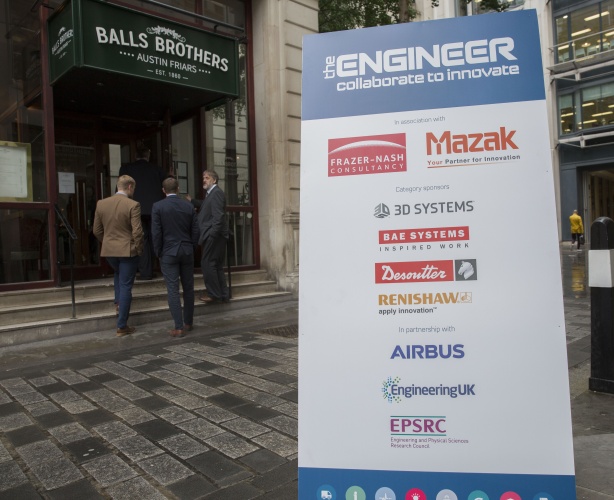Judged by a panel of leading UK engineers - and sponsored by Frazer-Nash Consultancy and Yamazaki Mazak - winning entries had to demonstrate that they were innovative, collaborative and likely to have an impact in their field of application.
The event provided a fascinating snapshot of some of the trends and technologies that are defining modern engineering, and also highlighted the degree to which industry and academia are collaborating to solve fundamental problems across a variety of sectors.
It also demonstrated, through its Young Innovator award, the ways in which industry and academia are finding innovative ways to work with schools in order to inspire the next generation of engineers.

The winners, listed in full below, will present their projects at The Engineer's Collaborate to Innovate Conference, which will be held on 7th December at Coventry's Manufacturing Technology Centre.
Category: Energy, Efficiency & Sustainability
Swansea Bay Tidal Lagoon
Atkins, Tidal Lagoon Power and LDA Design
Initial work on the 25GW Swansea Bay tidal power lagoon which, if it gets the go-ahead, will be the first of its kind in the world.
Category: Health & Wellbeing
Spiral Inducing Bypass Graft
University of Manchester, University of Michigan, Manchester Metropolitan University, National University of Singapore, Cardiovascular Research Institute - Sant Pau Hospital, Barcelona.
The development of a device that could prolong the life of artery bypass grafts by inducing the spiral flow produced naturally by the heart.
Category: Information, Data & Connectivity
Sponsored by Desoutter Industrial Tools
Using massive MIMO to set a world record in 5G wireless spectral efficiency
National Instruments, University of Bristol, Lund University, BT Group
Category: Safety & Security
A path towards safer lithium ion batteries
University College London (UCL), NASA, US Dept of Energy, The European Synchrotron, UK National Physical Laboratory
Important Pioneering research that has advanced our understanding of lithium battery failure.
Category: The Built Environment
Application of travelling fire methodology to the structural design of Lime Street's 38-storey Scalpel building.
Arup, Imperial College London
Category: Transportation
Sponsored by 3D Systems
Selective Catalytic Reduction technology for clean diesel engines
Loughborough University (Optical Engineering Research Group) Caterpillar, The Energy Technologies Institute and Johnson Matthey
Development of new selective catalytic reduction technology to make diesel engines cleaner.
Category: Young Innovator
Sponsored by Renishaw
Breaking the sound barrier with a model rocket car
The Joseph Whittaker School, Rolls Royce, Swansea University, Easy Composites, GS Products, IMeche, Santa Pod Raceway, GaaTech.
Category: Young Innovator - Engagement Initiative
Sponsored by Renishaw
SMASHfestUK Survival Village and Young Explainer Programme
Middlesex University, University of Greenwich, The Refinery, Telfscot Primary School, Invicta Primary School, Baring Primary School, Lucas Vale Primary School, Kender Primary School, St Mary's Lewisham CE Primary School, Rathfern Primary School, Woodcroft Primary School, Roe Green Junior School, St Thomas More Catholic Primary School, Conway Primary School, Discovery Primary School and Royal Greenwich Trust School.
Category: Academic Innovator
Sponsored by BAE Systems
The EPSRC Centre for Innovative Manufacturing in medical devices
University of Leeds, University of Bradford, Newcastle University, University of Nottingham, University of Sheffield, Ceramisys, Corinthian Surgical, DePuy Synthes, Eminate, Fripp Design, Glass Technology Services, JRI Orthopaedics, Materialise NV, NetComposites, NIHR LMBRU, Promethean Particles, Simpleware, Simulation Solutions and Surgical Innovations
A multi-university collaboration aimed at advancing innovation in UK healthcare technology.
Here’s what our judges had to say about this year’s shortlist:
“It’s a great illustration of the breadth and reach of engineering in all walks of society.”
Prof Andy Wright – Director Strategic Technology, BAE Systems Programmes and Support
“I think it’s great to see the way the UK wealth and future prosperity is underpinned by engineering innovation.”
Prof Tom Rodden – Deputy CEO, EPSRC
“It demonstrates the power of collaboration across a breadth of areas, both industrial and academic, and high level innovation, which is becoming even more important as we become an ex-EU member and have to collaborate widely across not just our own boundaries but also international boundaries.”
Alan Mucklow – Director, UK and Ireland Sales, Yamazaki Mazak
“The outstanding feature of the entries was the collaborative side of things: incredibly innovative companies working with outstanding academics.”
Jenni Sidey – Lecturer in Internal Combustion Engines, Cambridge University & Astronaut
“The thing that excited me as I went through was the breadth of stuff – from the rocket car right through to the research led innovation.”
Dr Chris Guyott – Engineering Director, Frazer-Nash Consultancy
“I think it’s really important that we reach out to the younger people – so it’s great to see two categories for young innovators.”
Prof Danielle George, University of Manchester
“The most compelling thing for me was optimism about the future. If you look at the number and depth of entries from young innovators I think there’s great confidence that the future of engineering is in great hands.”
Alan Newby – Director Aerospace Technology, Rolls-Royce Plc
“For me, it’s about the transfer of knowledge from different industry sectors – we’ve seen it with medical devices, aerospace and automotive.”
John Halton – Director, Business & Industry, Engineering UK
“There are some outstanding entries – for me it’s about the links between innovation and the big societal challenges. Plus, the contribution from the engineers of tomorrow is absolutely awesome.”
Prof Iain Gray – Director of Aerospace, Cranfield University
Collaborate to Innovate is supported by the following organisations:
Headline Sponsors
Category Sponsors
Partners





Nanogenerator consumes CO2 to generate electricity
Whoopee, they've solved how to keep a light on but not a lot else.